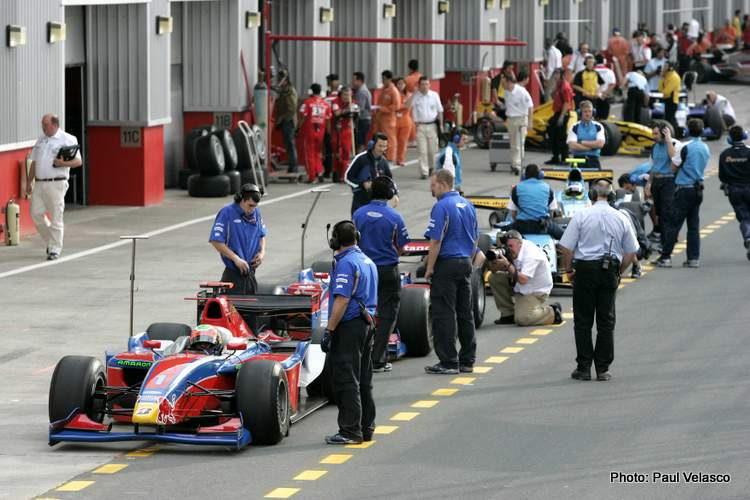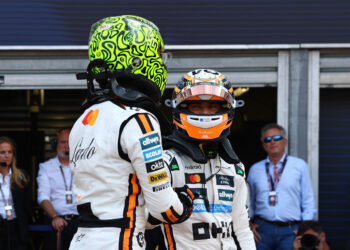In the world of motor sports, there have been numerous drivers who took different paths to reach Formula 1. While some, like Max Verstappen and Lance Stroll, chose to skip the F2 series due to their exceptional talent and financial support, most drivers used F2 as a stepping stone to their F1 dreams. Of the seven F2 champions, only Charles Leclerc (2017) and George Russell (2018) managed to achieve success in the pinnacle of motorsport, winning races.
Aside from Leclerc and Russell, the only other F2 champion who currently has a spot in F1 is Oscar Piastri, who clinched the title in 2021. Nyck de Vries (2019) and Mick Schumacher (2020) had their stints in F1 but have since moved on, while Felipe Drugovich (2022) and current F1 champion Théo Pourchaire are still fighting to secure a permanent place at the top of motorsport.
Before the creation of the GP2 Series in 2005, the first champion of its predecessor, the European F2 Championship, was Nico Rosberg in 2005. The following year, Lewis Hamilton emerged as the leader of Formula 1. Both Rosberg and Hamilton went on to become F1 world champions, with the latter achieving an incredible 103 wins and chasing his eighth unprecedented title.
Other notable GP2 Series champions who later competed in F1 for at least one season include Timo Glock (2007), Nico Hulkenberg (2009), Pastor Maldonado (2010), Romain Grosjean (2011), Jolyon Palmer (2014), Stoffel Vandoorne (2015), and the most recent GP2 Series champion, Pierre Gasly. Gasly is currently the only former GP2 Series champion still actively competing in F1, alongside Hamilton.
The transition from the European F2 Championship to the GP2 Series marked a significant turning point in the history of motorsport. On September 11, 2004, during the Formula 3000 race in Monza, the Arden International team, led by Christian Horner, emerged victorious with Vitantonio Liuzzi behind the wheel. This race signaled the end of the European F2 Championship, which had been in existence since 1985.
Subsequently, the beginning of the GP2 era started in 2005, thanks to the vision of Bruno Michel and Flavio Briatore, with the support of Bernie Ecclestone. The GP2 Series introduced a standardized format, with all drivers competing in identical cars, equipped with the same engine, tires, and chassis. This specific series aimed to provide young aspiring drivers a platform to showcase their skills and potentially follow in the footsteps of legendary figures like Michael Schumacher and Jim Clark.
In the first season of GP2 in 2005, there were 12 rounds of races. Each round consisted of a feature race and a sprint race, except for the Monaco round, which had only a feature race. The group of drivers included Scott Speed from California, who was a Red Bull junior. Additionally, there were three drivers who were sons of former F1 champions: Nelson Piquet Jr., Mathias Lauda, and Nico Rosberg. The drivers came from various countries around the world, including Argentina, Malaysia, Turkey, Japan, and Venezuela.
The first GP2 race took place on April 23, 2005, at the Autodromo Enzo e Dino Ferrari. French driver Nicolas Lapierre secured the pole position, while Ernesto Viso from Venezuela set the fastest lap. The race winner was Heikki Kovalainen, who had been the Formula Renault 3.5 champion and managed by Briatore.
Kovalainen had a strong start to the season, winning three out of the first five main races. Rosberg, on the other hand, had to wait until the fifth round in Magny-Cours to achieve his first victory in the sprint race. In the second half of the season, Rosberg had an exceptional performance, winning the next two main races in Silverstone and Hockenheimring.
Kovalainen kept his championship hopes alive by winning the sprint race at the Istanbul circuit and followed up with a victory in the main race at Monza. However, it was Rosberg who ended up becoming the first GP2 champion by winning both the sprint race and the main race in the final round of the season in Bahrain. He scored a total of 120 points, with Kovalainen finishing in second place with 105 points.
Rosberg’s success in GP2 earned him a spot at Williams in Formula 1, the same team for which his father had won the world championship in 1982. Lewis Carl Hamilton, supported by McLaren and Mercedes, joined ART Grand Prix for the 2006 GP2 season, replacing Rosberg.
The 2006 GP2 season consisted of 11 rounds, with Monaco once again featuring only one main race. The season began in Valencia under the Spanish sun, and Piquet Jr., who was in his second year of GP2 and was the favorite in the pre-season, won the opening race. In just his second GP2 appearance, Michael Ammermüller emerged victorious in the sprint race.
The third round at the Nürburgring was dominated by Hamilton, who won both the main race and the sprint race. He continued his success by winning the prestigious round in Monaco, starting from pole position, and then triumphed in Silverstone by winning both races of the weekend. One of the highlights of the Silverstone round was an overtaking move between Piquet Jr. and Clivio Piccione.
Although Hamilton did not win again in GP2 after Silverstone, his most impressive performance of the year came in the sprint race at the Istanbul circuit. Despite spinning and falling back, he managed to recover and finish in second place.
Although Piquet Jr. won half of the last six races, it was Hamilton who ended up claiming the title with 114 points, compared to Piquet Jr.’s 102 points.
The 2007 season of the GP2 racing series once again featured a diverse lineup of drivers from various countries, including Russia, India, Turkey, and China, in addition to the usual European and South American competitors. With 11 rounds, the Monaco race deviated from tradition by not including a sprint race. By the end of the season, both Flavio Briatore and Ron Dennis expressed their disappointment with the lack of talent among the grid’s drivers. This sentiment was supported by the fact that, out of the 30+ drivers who participated in GP2 that season, only one driver, Pastor Maldonado, managed to win a Grand Prix.
Timo Glock, a German driver, emerged as the champion of the GP2 Series in 2007, securing five victories over Brazilian Lucas Di Grassi. Glock’s only triumph of the season came during the main race in Turkey. Dallara, the exclusive chassis supplier for both the current Formula 2 and its predecessor GP2, introduced a new car for 10 rounds in the 2008 season. Notably, Monaco hosted both sprint races and main races for the first time.
In addition to Maldonado, other 10 drivers from the 2007 season went on to compete in Formula 1 with limited success. Karting prodigy Pantano clinched the championship with four wins, surpassing Bruno Senna. The GP2 and F2 championships have become crucial stepping stones for aspiring drivers before entering the world of Formula 1. A predominant trend suggests that winning the championship in the first year generally leads to securing a place in a reputable team at the top of motorsport. This pattern is exemplified by names such as Nico Rosberg, Lewis Hamilton, Charles Leclerc, George Russell, and Oscar Piastri, who clinched the title in their first attempts. It is not surprising that drivers who took two or more years to win the championship at this level have struggled to replicate the success achieved by the mentioned champions in their first year.
For example, Pierre Gasly triumphed in the championship during his second full season, while Nyck de Vries needed three years to achieve the same feat. Mick Schumacher secured victory in his second attempt. In contrast, both Maldonado and Felipe Drugovich won the championship in their fourth year, while Davide Valsecchi needed five seasons to clinch the GP2 championship.
In the case of Nico Hulkenberg, the driver who was previously managed by Willi Weber, he won the GP2 championship in 2009 in his first attempt. Hulkenberg had also achieved success in the F3 Euro and Formula BMW championships. Despite his decade-long presence in the competitive world of motorsport, Hulkenberg has yet to step onto the Formula 1 podium. It is worth noting that in the F1 era dominated by wealthy individuals, Hulkenberg managed to sustain his career without significant financial support.
On the other hand, drivers like Valsecchi and Fabio Leimer, who won the GP2 championship in 2012 and 2013, respectively, never had the opportunity to compete in a single Grand Prix. Stoffel Vandoorne, the GP2 champion in 2015, had a junior career similar to Hamilton’s, winning several championships before reaching Formula 1. However, his time at the top of motorsport was marked by two major setbacks, including being teammates with Fernando Alonso and driving a car equipped with an unsatisfactory “GP2” engine.
Formula 2, formerly known as GP2, underwent a name change for the 2017 racing season. The revamped series saw two consecutive rookie champions, Charles Leclerc and George Russell, both of whom achieved victories in Formula 1. These talented drivers are ready to become world champions once the dominance of Red Bull Racing and their star driver, Max Verstappen, comes to an end.
In addition to Leclerc and Russell, Oscar Piastri joins the group of rookie champions. Although he may not secure a championship in his papaya-colored car, the Australian driver has the potential to deliver impressive results if he has a competitive vehicle.
Interestingly, the only two world champions that GP2 has produced so far are Nico Rosberg and Lewis Hamilton, both champions in the early years of the series. It is also worth noting that two other drivers, who were part of the Red Bull junior program, won Formula 1 world championships without ever competing in GP2.
For example, Sebastian Vettel won four consecutive Formula 1 championships from 2010 to 2013. Before his Formula 1 career, he briefly competed in Formula Renault 3.5, following his team’s recommendation.
The story seems to repeat itself, as Max Verstappen is currently on track to win his fourth consecutive title at an impressive pace. Just like Vettel, the talented Dutchman was propelled into Formula 1 by the same influential figure after only one year in single-seater racing.
In conclusion, whether in GP2 or Formula 2, Formula 3 or Formula Renault 3.5, it is evident that the most talented drivers will always rise to the top.
© 2024
Formula 1 driver Max Verstappen secured an impressive victory at the Monaco Grand Prix on Sunday. Verstappen, from the Red Bull Racing team, led the race from start to finish and crossed the finish line in first place, securing his first win at the Monte Carlo street circuit.
The race in Monaco is known for its narrow streets and challenging corners, making it one of the toughest on the Formula 1 calendar. Verstappen showed skill and determination in overcoming the obstacles and staying ahead of his competitors.
Second place went to Mercedes driver Lewis Hamilton, who struggled to keep up with Verstappen’s pace throughout the race. Hamilton earned important points for the championship, but was unable to challenge the Dutchman for the lead.
Third place went to Ferrari driver Charles Leclerc, who put on an impressive performance in his home race. Leclerc, who is a native of Monaco, thrilled the local fans by stepping onto the podium and securing a solid result for the Italian team.
The Monaco race was also marked by some incidents. McLaren driver Lando Norris was forced to retire from the race after a collision with AlphaTauri driver Pierre Gasly. Norris was in a promising position before the accident and was frustrated by the situation.
Overall, the Monaco Grand Prix provided an exciting and action-packed race for Formula 1 fans. Verstappen showed his talent and determination, securing an impressive victory and establishing himself as one of the main contenders in the championship. The next race will be held at the Baku circuit in Azerbaijan, and fans are eager to see what will happen.










